and historical purposes, all rights reserved.
This page is copyright© by
This page may not be sold or distributed without
the expressed permission of the producer.
I have no connection with any camera company.
If you find this manual
useful,
how about a donation of $3 to:
M. Butkus, 29 Lake Ave.,
High Bridge, NJ 08829-1701
and send your
e-mail address
so I can thank you.
Most other places would charge
you $7.50 for a electronic copy
or $18.00 for a hard to read Xerox copy.
buy new manuals, and pay their shipping costs.
It'll make you feel better, won't it ?
If you use Pay Pal, use the link below.
Use the above address for a check, M.O. or cash.
Venmo @mike-butkus-camera Ph. 2083
<<< IF YOU WOULD LIKE THIS OR ANY PDF FILE
PRINTED, BOUND AND MAILED TO YOU,
SEE THIS OUTSIDE COMPANY'S OFFER >>>
Back to main camera manual page
CLICK HERE FOR Lordox 57 PDF
MADE FROM THIS PAGE
- BETTER PRINTING -
Congratulations on your discernment in choosing the Lordox. We are certain
and your pictures will prove - that your choice was wise. Please spend
some minutes before you take your first picture, to operate the camera as you
read these instructions. The Lordox takes 24x36 mm pictures on 35mm. width
film. You may use either black and white or color films in cassettes
(cartridges) of 20 or 36 exposures.
And here are some hints for your guidance:
Loading:
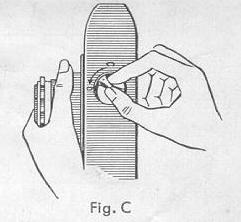 |
As shown in illustrations C and D unlock the camera by turning the lock at the base from C to O (open), then take off the camera back. Place the film cassette into the empty space of the camera body so that the prongs of the rewind knob (A,8) engage in the cassette. |
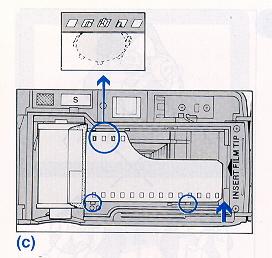 |
Draw the end of the film across and thread it through the slot (B. 25) of the take-up spool (B,24) until it extends about 1/2" out of the other side. Turn the rapid lever winder (A,1) twice (Fig. E) and ensure that the film is wound at least once around the take-up spool (B,24) and that the lower sprockets (B,23) engage in the film perforations. Make that the film is snug against the bottom of the slot (b,25) and by turning the rewind knob (B,8) in the direction of the arrow that it is firmly pressed against the film guide Fig. D of the camera and lock it by turning the bolt to C (closed). |
 |
 |
Setting the Film Counter Dial:
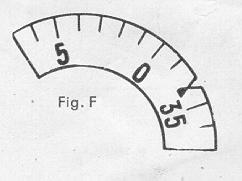 |
As described above, turn the rapid lever winder (A,1) twice thus setting the shutter. Now, using the film release knob (A,3) set the black triangle between O and 35 on the film counter dial (A, 4) opposite the pointer (Fig. F) Press shutter release button (A 2), wind on the film by the two movements of lever (A, 1), release the shutter, and again repeat the film-winding movement. The film is now at 0, the shutter is set, and you are ready to make your first exposure. |
Focusing:
Turn front lens ring (A, 18) until the measured or estimated
distance in feet is opposite the red mark on the depth-of-field ring (A,13) 13).
The 00 means "infinity" or long distance.
Lens Apertures:
The Lordox has the following apertures: 2.8; 4; 5.6; 8; 11; 16; 22.
F/2.8 is the largest, F/22 the smallest aperture. These apertures are engraved
in black numbers with the exception of F/8 which is frequently used and
therefore indicated in red. To obtain the aperture you wish to use press the
coupling lever (A,11) and turn the aperture scale ring (A,10) until the desired
lens aperture is opposite the red mark (A,9). ,
Setting Shutter Speed:
While pressing the coupling lever (A,11) turn the milled ring (A,
16) until the desired speed is opposite the red mark (A, 9). The 9 speeds are 1
second (1), /e second (2), I/` second (4), 1/8th second (8), 1/15th. second (15)
1/30 th. second (30), 1 /60th. second (60),1/125th. second (125), 1 /300th.
second (300) and B (brief). The black numbers on the speed ring (A,12) -except 1
which means a full second - are fractions of a second. The green numbers (4 to
60) are full seconds and are intended only to assist in calculating the relative
aperture needed for each exposure duration. if you have to expose for longer
than 1 second, you must set the shutter at B. In this position, it will remain
open as long as you press the shutter release button (A, 2).
Exposures of 1/30th. sec. or faster can be made whilst holding the camera in the
hand, but far 1/15th. sec. or slower, also B. a tripod or firm support is
needed.
Exposure-Value Setting:
The Prontor S.V.S. Shutter fitted to the Lordox is of the
Exposure-Value type. This means that the lens aperture and shutter speed are
automatically coupled the combination thus ensuring uniform exposures. Each
combination is expressed by a single number which is called
the Exposure-Value.
This example shows how the combination works:
Exposure-Value 9
| Shutter Speed | 60 | 30 | 15 | 8 | 4 | 2 | 1 |
| Lens Aperture | 2,8 | 4 | 5.6 | 8 | 11 | 16 | 22 |
Thus, if the correct exposure is 1/8th. sec. at F/8, it is likewise 1/15th. sec. at F/5.6, or 1/60th. sec. at F/2.8 etc.
Using the green scale of figures:
Exposure-Value 6
| Shutter Speed | 8 | 4 | 2 | 1 | B=2 sec. | 4 sec. | 8 sec. |
| Lens Aperture | 2,8 | 4 | 5.6 | 8 | 11 | 16 | 22 |
The parts of the LORDOX 57
 |
1. Rapid wind 2. Shutter release button 3. Release Knob 4. Film counter dial 5. Accessory shoe 6. Viewfinder window 7. Film type indicator 8. Rewind knob 9. Mark indicating aperture and speed 10. Lens apertures 11. Coupling lever 12. Speed scale 13. Depth-of-field ring 14. Distance scale 15. Flash synchronization contact |
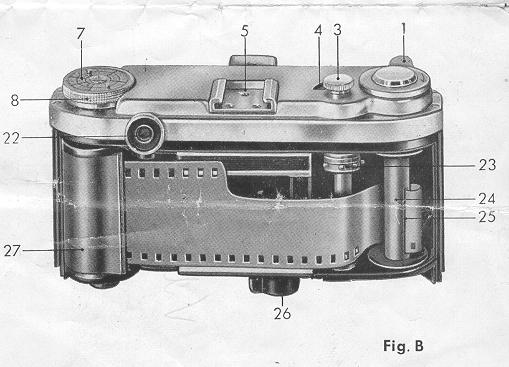 |
16. Milled ring |
Thus, if is necessary to stop down to F/11, the 2 sec. exposure needed would
equal 4 sec. at F/16.
To obtain the required position of the red figure denoting the Exposure-Value,
press down the coupling lever (A,11) and revolve the ring (A, 12) until the
number comes against the red indicating triangle.
If you own an exposure meter which gives the Exposure-Value readings, you have
only to set the required number on the scale. It should be noted that if you
change the speed setting from 1/125th. to 1/300th. 1 1/2 steps of the normal
progression results so that it follows that the change in aperture should be
proportionate, i. e. from F/5.6 to F/3.5 which represents an increase of 1 1/2
steps. It is possible to set the aperture control between the engraved figures,
e. g. F/3.5 between F/2.8, and F/4 or F/12.5 between F/11 and F/16 but the speed
ring must be set at click stops positions only and not at intermediate mediate
positions on the scale.
If when changing from a low Exposure-Value number e. 9. 5 to a higher one such
as 12, you find you cannot proceed to turn the Exposure-Value setting ring (A,
10) because it is locked on the right side by a stop at aperture 22 or speed B.
you must release the coupling lever (A,11) and turn the milled ring (A, 16) to
the right side as far as the movement is arrested by the left stop at aperture
2.8, or the left stop at speed 300.
Similarly, when you wish to move the speed control from a high Exposure Value a
lower one, you must operate the milled ring in the opposite direction after
having pressed down the coupling lever (A,11). In both cases, you can then turn
the aperture setting ring (A, 10) whilst pressing down the coupling lever (A,11)
so that the desired Exposure-Value number comes opposite the red triangle.
Self Timer: (Delayed Action)
This device permits you to photograph yourself. After having set the shutter
turn the synchronization switch lever (A, 17) to V (green) position. Press the
button (A,2) when the self timer mechanism will commence to operate and the
shutter will be released after a delay of 7 to 8 seconds which is sufficient
time for you to walk in front of the camera. When using the delayed action
device, place the camera an a tripod or other firm support. Delayed action
pictures are possible at all shutter speeds except B. After the exposure has
been made, the lever (A, 17) will automatically return from .V to the X
position.
Taking Flash Pictures:
There are different classes of flash bulbs usually designated X or
M by the respective makers of the bulbs. The synchro switch lever (A, 17) must
therefore be set to either X or M according to the class of bulb in use, X being
for exposures with flash bulbs up to 1/30th. sec. or for exposures at any speed
with electronic flash up to 1/300th sec, while M is for exposures with M
type flash bulbs at any speed (except B). You may also take delayed action
pictures while using flash, in which case you'll set the synchro switch lever
(A, 17) at V and use a shutter speed of up to 1/30th..second with flash bulbs
(regardless of the class of flash bulbs employed) or up to 1/300th. sec. when
using electronic flash, so that in effect, the V setting has the same operation
with flash as the X setting. When using an electronic flashgun that has a zero
millisecond delayed attachment, you may likewise use any shutter speed except B.
also if you are making delayed action exposures.
It is immaterial, when taking ordinary daylight exposures without
flash, whether the synchro switch lever (A, 17) is at X or M.
Depth -of -field:
By means of the hyper focal scale (A, 13) you may determine in
anticipation the range within which your picture will be sharp. As an example
for near subjects, set the focusing distance at 7 ft. with the aperture at F/11.
On the depth-of-field ring (A,13), you will see the No. 11 twice, on the right
and on the left of the red diamond. Over the left hand 11 on the distance ring
(A,14) you see 5 ft. and aver the right 11, there is 10 ft. Your picture will
therefore be sharp in a zone from 5 to 10 ft. away. For distant subjects, you
preferably set the distance at 20 ft. stopping down to F/11. You thus obtain a
depth-of-field ranging from 10 ft. to infinity.
Rewinding film:
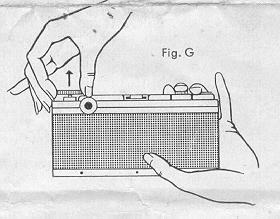 |
As shown in illustration G. press the film release knob (A, 3) and pull out the rewind knob (A, 8). Then turn the rewind knob in the direction of the arrow until you feel no tension. This indicates that the Exposed film is back in the so may then Open the camera and extract the film for processing. |
Cable release socket:
Inside the shutter release (A,2) there is a thread for fitting a cable
release. It is preferably to use this release when taking pictures at speeds
slower than 1/30th second, and always at the B position, to avoid camera-shake.
The tripod bush is placed near the center of the camera base and accepts all
standard 1/4" tripod and flashgun screws.
* * On the top of the LORDOX, the slotted shoe is intended for accommodating a flash gun, range finder, or exposure meter. The little spring inside the shoe ensures that these accessories will be held firmly
* To remind you of the type of film in the camera, set
the dial (A,7) when loading. The outside row of figures are ASA (arithmetical)
film speed ratings, the inner row being the German DIN speeds. Place the
corresponding number against the block dot. For color films, set against IN for
indoor {Type A) film, or OUT for outdoor (Daylight) type color film.